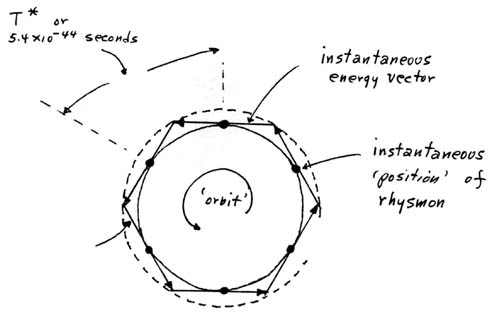Rhysmonic Structure
(4-1-1988)
The rhysmoid is formed of many individual rhysmons which are interlocked as a matrix-type structure in a 3-dimensional configuration. It is difficult to visualize this active structure except in an "instant" of time, where the rhysmon's position can be considered to be momentarily "frozen" in time. Consider a single rhysmon in a planar "orbit" as depicted in Figure 1. This rhysmon is depicted in six momentary positions, separated in time at each position by the Panck Time, T*, of about 5.4 x 10-44 seconds. At each of these "instants" in time, the rhysmonic vector may be considered as a "force" directed tangentially to the radius of the orbit path at that particular instantaneous position. It should be remembered that when the entire rhysmonic matrix structure is considered, each of the instantaneous rhysmon positions shown in Figure 1 would actually be occupied by a different separate individual rhysmon of the matrix structure. Therefore, the instantaneous forces as depicted there would construct the typical hexagonal force structure normally depicted in this rhysmonic cosmology. When the other rhysmons in an extended volume are also considered, the forces present in each of the unit cell structures will "intermesh" with the other cell structures and thus will build-up to make the rhysmoid, i.e., the vacuum substratum, or aether, of this universe.
Rhysmonic Forces:
As depicted in Figure 1, the dynamic energy vectors of each individual rhysmon will be directed in all possible directions in the plane of their orbits as a function of each instantaneous time period, but each individual rhysmon will return to its original vector direction after a time period of 6T*. Moreover, in the case of the 3-dimensional configuration of a basic matrix cell structure, as shown in Figure in the Monograph Rhysmonic Cosmology for a particular instant of time, the dynamic energy vectors will be directed over every conceivable possible direction in space during the course of the instantaneous positions of each individual rhysmon in that same time period of 6T*. These impulse forces in space will thus be a function of and related to Planck's Constant, h.
For an extended planar rhysmonic structure, or an extended 3-dimensional rhysmonic structure, the rhysmonic energy vectors will also "interlock" to form universe-wide similarly directed (when not disturbed) energy vectors in the universe. These, when aligned, will be those instantaneous straight-line Euclidian-type vectors in free space which are fundamental to the phenomena of gravity. However, any changes in the energy density for the rhysmonic matrix structure will introduce what will now be recognized as mass (matter) and fields (forces) by man and his instrumentation. However, the undisturbed rhysmoid would be "unobservable" since it exists as a perfectly balanced energy system where all vectors are "cancelled" and thus can present no outward effects.
What Are Rhysmons?
What rhysmons may be or not will be even more conjecture than the present theory and thus that aspect will not be extensively considered here. It is difficult enough to describe the rhysmoid (or aether) without introducing more questions right now. Perhaps, the rhysmon may be a universe in itself, and out Universe might be a rhysmon of an even larger universe, and so on ad infinitum in both direction. Such a system of universes has been suggested in the past.
Conclusions:
Rhysmonic cosmology is a dynamic theory which, when fully developed, might go a long way in explaining reality at both the macroscopic (chemical and astronomical) levels, as well as the microscopic (atomic and sub-quantum) levels. It appears to be having some success thus far even in its early stages of development. You, the experimenter, can become a vital force in these developments.
Figure 1: Depiction of rhysmon in "orbit" in six successive instantaneous positions as separated in Planck Time, T*. It should be noted that there are many such instantaneous type hexagonal structures for each instant in time, thus the hexagonal structure could be considered as "rotating" in time.
